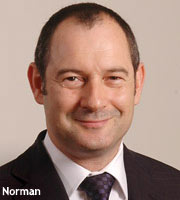
What's the next big technology for the advertising industry? It depends on who you ask at the 2012 Consumer Electronics Show (CES). Google Chairman
Eric Schmidt points to the latest Android operating system Ice Cream Sandwich built into products like Lenovo's smart TV that will begin selling initially in China this year. Ask an ad agency
exec and the answer will differ.
Technology beginning in one platform continues to make its way into another. Take the 4K digital format, for example, led by Hollywood studios. Sony pioneered
the technology in digital cinema projection systems for theatrical releases, but at CES debuted 4K in a big-screen TV home theatre system.
The next wave of technology for advertisers seen at
CES will come from high-quality big screens, as well as the interface found in tiny screens on mobile devices, confirms Rob Norman, GroupM CEO of North America. The resolution on screens will continue
to improve, enabling better use of apps and text -- especially on big screens. "If we get to between 60% and 70% of the install base having higher-resolution screens in the home connected to the
Internet, we'll start to see more social interactive ads," he said, because until now that has been difficult to achieve.
advertisement
advertisement
The inability to interact with Twitter and Facebook posts on big
screens at today's TV resolutions without gesture and voice controls available in tools like Microsoft Kinect seemed to stifle adoption. Brands will increase their use of social campaigns once screen
resolutions improve, Norman said. Virtual reality, which in some cases pulls in real-life surroundings onto the screen, will also have an impact. "If we can create a video-and-data experience, and
remove the remote control and the mouse click, the ads come to life through the technology," he said.
The Microsoft Windows 8 operating system (OS) interface born from Windows Mobile, which
makes the transition from the small mobile screen to the desktop -- and even, perhaps, the TV -- will also attract advertisers. When asked how Windows 8 and the Metro interface will influence search
engine marketing, Norman said search queries connect to content via data, making it discoverable through voice and gestures. The two, however, will require new metrics to track success or failure.
Norman said "broad reach media" will remain expensive, but social through sharing can increase a brand's campaign return on investment.
Over at IPG Media Lab, which launched in November to
make brands aware of emerging technology that could evolve into tools for campaigns, Managing Partner Chad Stoller points to a Xperia-branded near field communication (NFC) tag that provides pre-set
functions for Sony phones. One affixed to the threshold of an office, for example, might turn off personal email or the ringer on the smartphone, he said. This type of technology would create
sponsorship opportunities for brands like Coca-Cola.
IPG doesn't only consider the technology -- but rather, will the technology drive adoption, Stoller said. "From there we determine if the
medium has applicability," he said -- but the leading use will become payments, and today that means carriers, banks and hardware manufacturers must agree on one standard and common spec, putting it
at a huge disadvantage.
Wearable computers -- small devices running on the Android operating system
(OS) -- will become a basis for collecting data. The key for IPG is to find the technology and determine how it will work to support advertisers.